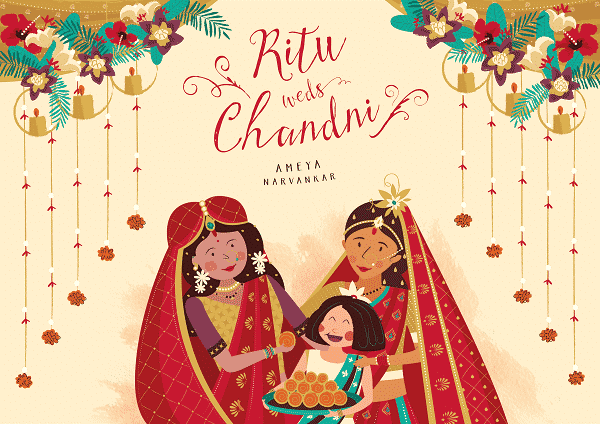“But what is wrong with that? Why shouldn’t she marry Chandni didi?,” asks Ayesha, the young protagonist in Ameya Narvankar’s Ritu weds Chandni.
The innocent question is enough to plant the seed of questioning within the minds of budding readers about the nature of queer acceptance in Indian society.
Ritu weds Chandni is a children’s picture book about Ayesha, a young girl who is impatiently waiting to dance in her cousin Ritu’s baarat (a lively wedding procession with music and dancing). Ritu is marrying her girlfriend Chandni, but not everyone approves of the celebration; some relatives, neighbours, and even strangers protest by literally ‘raining’ on their parade.
Artist, illustrator, and writer Ameya Narvankar believes in ‘design for change’ and is determined to use his talents to create a positive impact on society. In 2015, while pursuing a Masters of Design at IIT-Bombay, he chose a thesis subject that would eventually culminate into a unique story curated for kids in their formative years.
“I explored the subject ‘The visibility & representation of LGBTQ+ in Indian Society’ for my thesis. I looked at various portrayals of the queer community in popular media and art, especially those catered towards younger audiences. I found that the mainstream has shied away from accurate representation and often the depictions have been cruel and downright homophobic,” he told Indian Link. “As a gay man who grew up on a staple of Bollywood, these depictions always bothered me. My findings and research trickled down to me focusing on children’s literature and I wrote Ritu weds Chandni in an attempt to create better representation avenues which in turn would bring greater awareness on the subject.”

Although homosexuality has been decriminalised in India, same-sex marriage is still illegal in the eyes of the government. Nevertheless, Ameya wanted Ritu and Chandni to have a happy ending.
Young Ayesha doesn’t let the bigots and naysayers dampen the wedding party, her excitement of celebrating the family’s first bride leading her own baarat cannot be contained.
“I wanted to draw a parallel with a pride parade, and at the same time also challenge gender roles by having a bride on a horse,” Ameya explained.
The innate joy of participating in her cousin’s wedding makes Ayesha overcome all negativity and restores a festive we-will-celebrate-no-matter-what mood to the wedding party.
READ ALSO: Diwali in children’s literature: An engaging book by James Roy
View this post on Instagram
Weddings in Indian society are a grand and overt sign of acceptance, with the baraat being “a very recognisable symbol” of North Indian weddings. Since the premise of Ritu weds Chandni is set in such a common Indian environment, it adds to the visibility of same-sex love in a positive light and leaves readers rooting for the couple.
“The moment I started writing the book, I wanted the two brides to have their happy ending. It is very Bollywood-like and perhaps unrealistic. But I choose to embrace it; after all, Bollywood is a major part of the lingua franca of our present society,” he said.
Moreover, Ameya deliberately chose women to be the main characters in the story.
“I believe intersectionality is the backbone of every social movement. In a patriarchal Indian society, the status of queer women is even further marginalised,” the progressive artist added. “By shining the spotlight on two women in this story, my hope is that the conversation around this book will be multi-faceted and nuanced in its discussion of human rights.”
Ameya Narvankar refers to himself as an “accidental author” with design/art being his main calling. His soft illustration style in the book is very calming and wholesome. He illustrates the brides, their ornaments, their lehengas (not forgetting their mangalsutras and sindoors), wedding attendees and ceremonies vibrantly with attention to detail (even the mehendi on the brides’ palms is pleasing to the eye). Although Ameya’s storytelling is quite adroit, the illustrations are so meaningful that they could convey the plot without needing any words!

Even though Ritu weds Chandni incorporates a lot of non-English vocabulary, the inclusive text published by Yali Books does not restrict itself to audiences who understand Hindi. The book comes with a glossary of terms at the end, to help readers of different backgrounds understand all the elements in the story.
Ameya’s intention was to inculcate a sense of critical thinking within children without overwhelming them with hardships faced by the LGBTQ+ community, but also at the same time not paint “too rosy a picture”. He’s achieved just that; his contribution adds to the visibility of non-heteronormative love and the erosion of stigma surrounding the subject.
Parents who think introducing queer love and acceptance to their children will be tough, Ritu weds Chandni is a precious piece of children’s literature that will help your kids realise on their own that every person irrespective of gender and sexuality has the right to lead their life with dignity and freedom.
WATCH ALSO: South Asians talking about Mardi Gras
Link up with us!
Indian Link News website: Save our website as a bookmark
Indian Link E-Newsletter: Subscribe to our weekly e-newsletter
Indian Link Newspaper: Click here to read our e-paper
Indian Link app: Download our app from Apple’s App Store or Google Play and subscribe to the alerts
Facebook: facebook.com/IndianLinkAustralia/
Twitter: @indian_link
Instagram: @indianlink
LinkedIn: linkedin.com/IndianLinkMediaGroup




